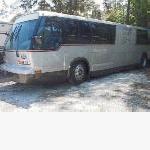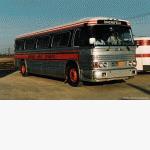| Author | Message | ||
| Geobus (4108gmc)
Registered Member Username: 4108gmc Post Number: 69 Registered: 6-2004 Posted From: 75.231.173.153 Rating: N/A |
I just enjoyed a substantial increase in MPG with my pickup by going 55. I have a 4108 GMC with an automatic. Without spending a lot of time testing speed vs MPG, does anyone know if 1) Will the slower I go with my coach continue to increase my MPG? 2) If 1) is no, then about what speed should I be looking at to get the BEST MPG? I am in no big rush. So, if 45 mph will increase my MPG I would go 45. I think others may join me, since I just returned home in my pickup doing 55 mph and I had 18 wheelers following me on the interstate. | ||
| doug yes (Dougg)
Registered Member Username: Dougg Post Number: 52 Registered: 1-2007 Posted From: 75.91.88.164 Rating: N/A |
55MPH? Is Carter running for prez? | ||
| Tom Caffrey (Pvcces)
Registered Member Username: Pvcces Post Number: 1206 Registered: 5-2001 Posted From: 65.74.72.93 Rating: N/A |
Geobus, light load efficiency is lower than heavy load efficiency; this is why mileage will not keep rising as you go slower. With our stick shift, and our engine not fully broken in, our mileage peaked at 62-65 MPH. Your peak speed will depend on which automatic you have, which injectors and which timing. Tire pressure will also affect it. I would expect the VS2 peak to occur at a higher speed than the V730, depending on the final ratio you wound up with. Our final ratio is 3.33:1 and our coach weighs about 27,000 pounds. For what it's worth. Tom Caffrey PD4106-2576 Suncatcher Ketchikan, Alaska | ||
| R.C.Bishop (Chuckllb)
Registered Member Username: Chuckllb Post Number: 293 Registered: 7-2006 Posted From: 4.240.213.213 Rating: N/A |
Could be wrong....but me thinks it was Nixon....early 70's (73?). My last trip, early this month, 100 miles one way, I drove 55...no hurry. Can't say I saved a bunch,but, who knows....perhaps. Up mountains, long straight stretch, both directions. Maintained about 10 mpg average. Have done 12 with looong straight. FWIW RCB | ||
| john w. roan (Chessie4905)
Registered Member Username: Chessie4905 Post Number: 1166 Registered: 10-2003 Posted From: 71.58.48.228  Rating: N/A |
Gentler acceleration, which is harder with an air throttle, couple hundred lower rpm at shift points ie- 1900 vs 21 or 22 hundred, driving 55, cutting down idling,anticipating your stopping or slowing down and also save brake lining.Using block heater and outside air source to pre charge air system. it'll all help. Don't lug engine though; it'll burn MORE fuel. | ||
| Pete/RTS Daytona (Pete_rtsdaytona)
Registered Member Username: Pete_rtsdaytona Post Number: 478 Registered: 1-2005 Posted From: 72.189.24.90  Rating: N/A |
this may help see--> http://www.solusinc.com/horsepower.html buses have a Cd of approx .5 also see--> (this is for cars ??) http://www.eartheasy.com/live_fuel_efficient_driving.htm also see--> (for trucks) http://lifeontheroad.com/2007/10/29/aerodynamic-trucks/369.html Rock-Solid Rules § Every 2% reduction in aerodynamic drag results in approximately 1% improvement in fuel economy. § Above 55 mph, each 1 mph increase in vehicle speed decreases fuel economy by 0.1 mpg. (Drive 65 vs 75 and save 1 mpg regardless of the truck you drive. Thats about $10,000 a year if you drive 100,000 miles) § Worn tires provide better fuel economy than new tires, up to 7% better fuel economy.(Brand new vs. end of life) § Used lug drive tires can get up to 0.4 mpg better than new lug tires. (used means broken in) § Ribbed tires on the drive axles provide 2–4% better fuel economy than lugged tires. (new vs new) § Every 10 psi that a tire is underinflated reduces fuel economy by 1%. § The break-in period for tires is between 35,000 and 50,000 miles. § Tires make biggest difference in mpg below around 50 mph; aerodynamics is the most important factor over around 50 mph. § The most efficient drivers get about 30% better fuel economy than the least efficient drivers. § Idle time is costly. Every hour of idle time in a long-haul operation can decrease fuel efficiency by 1%. | ||
| FAST FRED (Fast_fred)
Registered Member Username: Fast_fred Post Number: 358 Registered: 10-2006 Posted From: 208.100.193.130 Rating: N/A |
Your DD was designed to be as efficient as most engines at 1800rpm. This will be cheapest cruise speed. The fuel consumption isn't 'that bad " about 10% over that , we use 1950 rpm and still usually get over 9mpg . With our Mountain Gear (4905 pumpkin in a Sportscar 4106 ) we see 70 mpgh at cruise. FF | ||
| Geobus (4108gmc)
Registered Member Username: 4108gmc Post Number: 70 Registered: 6-2004 Posted From: 72.111.23.82 Rating: N/A |
What is the fuel consumption at fast idle for an 8V71? Is it gallons per hour? | ||
| Buswarrior (Buswarrior)
Registered Member Username: Buswarrior Post Number: 1301 Registered: 12-2000 Posted From: 76.68.134.96  Rating: N/A |
As a rough place to start thinking, a big diesel highway engine will burn a gallon of fuel an hour when idling. Fast idle on our buses will increase that. So at base idle, at $4.00 a gallon, that is almost 7 cents a minute ($0.0666 cents) to let the big engine run. At $5.00, 8 1/3 cents a minute. Yup, all those trucks and buses at the rest stops are spending money at quite a rate, eh? Don't run the engine unless it is pushing you down the road! Pushing the wind is the big issue for highway fuel economy. More wind, way more fuel. Running the engine close to the point where the torque and horsepower curves cross is another key to maximizing the forward push for every drop of fuel poured down its throat. Care needs to be taken when adjusting speed for maximum effect on fuel economy, you can outguess yourself. Many of the tractor trailer folks make the mistake of having the truck built with the gearing suitable to run at the wrong speed, and can actually face a fuel economy penalty if they shave 4 or 5 mph off, as the engine is out of the sweet spot. And, busnuts who do power train upgrades may suffer the same fate. The modern big Caterpillars are extremely sensitive to being run in the right RPM range for good economy. Respected old timers used to say horsepower is just another measurement of fuel consumption. Figure out how to use less power, you'll use less fuel. Gentler acceleration, slow down, push a little less wind, lighten the load in the coach, let the speed fall off cresting the hill, use the brakes less, shut the engine off when sitting... we gotta keep our dough to spend on other good things! happy coaching! buswarrior | ||
| Geobus (4108gmc)
Registered Member Username: 4108gmc Post Number: 71 Registered: 6-2004 Posted From: 72.111.23.82 Rating: N/A |
Just a side note: In WI we are at $4.80 per gal. Wow. | ||
| Gus Causbie (Gusc)
Registered Member Username: Gusc Post Number: 670 Registered: 11-2005 Posted From: 208.54.200.148 Rating: N/A |
Pete, I don't buy the worn tire gives better mileage theory for the following reasons; @ Worn tires have more rubber on the road thus more friction. More friction - more rolling resistance - more fuel. Dragsters use slicks for that very reason. @ In the days before power steering I remember how much easier my autos steered when I bought new tires. @ Even if it is true the dangerous trade off is severe hydroplaning in wet weather, that alone is enough to shoot down that idea. | ||
| JC Alacoque (Jc_alacoque)
Registered Member Username: Jc_alacoque Post Number: 65 Registered: 7-2006 Posted From: 72.45.68.242 Rating: N/A |
The two buses in my life now are two different pictures mpg-wise. My 1957 Courier 96, 4-71T,180 to 200 hp,5 speed Spicer, gets about 15 mpCdngal(12.5mpUSgal). I only drive one way: my foot to the floor all day. It is underpowered by today's standards, normal in the 50s. The hockey team's 102D3, S60, 7 speed manual, 400hp gets 9 mpg if driven easy at the speed limit, and 8 if pushed like running on the freeway at 120 km/h. That's 7.5 and 6.8 mpUSgal, about a 10% difference between easy and pushing it. The biggest difference between the 2 buses is horse power, followed by aerodynamics: the old bus is smaller (pushing less air), and much more rounded in shape than the brick that the 102 is. Weight is a factor as well: 23000 vs 40000 lbs. An interesting note about the 102 is when driving slower in snow in the winter, I spend more time in 6th gear than 7th, and I still get better mileage than going fast in 7th gear. I think it is because it is running in its sweet spot at 15 to 1800 rpm, pushing less wind than the same rpm in top gear at faster speed. Just my non scientific observations. FWIW. JC | ||
| George M. Todd (George_mc6)
Registered Member Username: George_mc6 Post Number: 456 Registered: 8-2006 Posted From: 76.91.197.153 Rating: N/A |
About a year ago, someone published an excellent article on Detroit fuel economy. If I remember correctly, the best engine economy was in the middle 1700 rpm range. Below that, all of the fuel has burned before the piston gets to the bottom, so it quits pushing. Above that rpm, the piston gets to the bottom before all of the fuel has burned, so energy is wasted out the exhaust. Its in the archives by now... G | ||
| RJ Long (Rjlong)
Registered Member Username: Rjlong Post Number: 1380 Registered: 12-2000 Posted From: 67.181.166.160  Rating: N/A |
GMC designed the powertrain of the 8V71-powered 4106 to run 60 mph at 1650 rpm with tires that turn 495 revs per mile. Since GM had a lot more geeks with slide rules working on these kinds of things, one would tend to think that 1650 - 1700 is the "sweet spot" for the stock 8V71. . . FWIW & HTH. . .  | ||
| FAST FRED (Fast_fred)
Registered Member Username: Fast_fred Post Number: 360 Registered: 10-2006 Posted From: 208.100.193.228 Rating: N/A |
Respected old timers used to say horsepower is just another measurement of fuel consumption. On a DD at a good place 16Hp will be created from every GPH. The newest turboed. aftercooled with electric injection can get 22hp , and some when loaded for perfection (a huge gen set constant rpm & loaded to perfection) can see 24hp/gal. FF | ||
| john w. roan (Chessie4905)
Registered Member Username: Chessie4905 Post Number: 1171 Registered: 10-2003 Posted From: 71.58.48.228  Rating: N/A |
Some of those sweet spots were more for driveability and grade handling with minimum of downshifting. Fuel consumption was considered, but not like today. Back then @15 to 20 cents a gallon fuel consumption wasn't as important as performance with a load of passengers and luggage. That sweet spot that is talked about is going to depend on std or advanced timing, overall gearing, and also injector size to some extent. Don't forget the VS2-8 which caused cruising well below 1700. Every coach is going to have a different sweet spot for best mileage. Combined with some conservative driving techniques. Everyone should be able to conserve fuel regardless. Do some experimenting and see what you can do. |